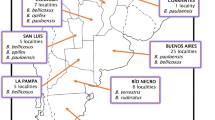Abstract
Larvae of the mite Trombidium newelli Welbourn and Flessel are ectoparasitic on adult alfalfa weevil, Hypera postica (Gyllenhall), an insect pest of alfalfa. The mite larvae are found under the elytra, attached to the dorsal surface of weevils’ abdomen. T. newelli larvae use their chelicerae to penetrate the pliable and weakly sclerotized areas of the host’s integument, and to hold on firmly to the host. The attachment sites associated with larval mites of different degrees of engorgement were examined using both light and scanning electron microscopy. The ventral inside surface of parasitized host tergites revealed a characteristic injury as spots varying in color from white-yellow to golden-brown depending on the engorged size of the mite. In addition, spots associated with fully engorged mite larvae showed an aggressive dendritically radiating mass expanding outward from the site of cheliceral penetration. This mass, known as feeding tube or stylostome was branched, with each branch ending in a cluster of closed bulbs. Stylostomes appear to exist independently in the host’s tissue. Stylostome mass corresponded with the engorgement state of the mite, increasing as the mite larva increased in size. The possible nature and mechanism of stylostome formation is discussed.
Similar content being viewed by others
References
A. Åbro (1979) ArticleTitleAttachment and feeding devices of water-mite larvae (Arrenurus spp.) parasitic on damselflies (OdonataZygoptera) Zool. Scr. 8 221–234
A. Åbro (1982) ArticleTitleThe effects of parasitic water mites larvae (Arrenurus spp.) on zygopteran imagoes (Odonata) J. Invert. Path. 23 229–231
A. Åbro (1984) ArticleTitleThe initial stylostome formation by parasitic larvae of water-mite genus Arrenurus on zygopteran imagines Acarologia 25 33–45
A.M.R. Bennet G.G.E. Scudder (1998) ArticleTitleDifferences in attachment of water mites on water boatmen: further evidence of differential parasitism and possible exclusion of a host from part of its potential range Can. J. Zool. 76 824–834
D.J. Borror C.A. Triplehorn N.F. Johnson (1989) An Introduction to the Study of Insects Saunders College Publishing, HoltRinehart and Winston Inc. OrlandoFlorida
C. Davids (1973) ArticleTitleThe water mite Hydrachna conjecta Koenike1895 (Acari: Hydrachnellae), bionomics and relation to species of Corixidae (Hemiptera) Neth. J. Zool. 64 363–429
G.O. Evans (1992) Principles of Acarology C.A.B. International Oxon, UK
Z. Feider (1956) ArticleTitleAcarieni no ζ, paraziti de insecte daunatoare apartinind genului Phylloterta Anal Stiit. Univ. Al. I Cuza. Iasi(N.S.) (Sect. 2) 2 119–161
M.R. Forbes K.E. Muma B.P. Smith (1999) ArticleTitleParasitism of Sympetrum dragonflies by Arrenurus planus mites: maintenance of resistance particular to one species Int. J. Parasitol. 29 991–999
C.A. Lancini B.P. Smith (1989) ArticleTitleConstancy of stylostome from two water mite species Can. Entomol. 121 439–443
Makol J. 1996. Trombidium Fabricius, 1775 (Trombidiidae) – what’s wrong and what’s right. In: Mitchell R., Horn D.J., Needham G.R. and Welbourn W.C. (eds)Acarology IX: Vol. 1, Proceedings, Columbus, Ohio Biological Survey, PP. 355-357
J. Makol A. Wohltman (2000) ArticleTitleA redescription of Trombidium holosericeum (Linnaeus, 1758) (Acari: Actinotrichida: Trombidioidae) with characteristics of all active instars and notes on taxonomy and biology Ann. Zoolici (Warszawa) 50 67–91
A.M.A. Mohamed D.B. Hogg (1997) ArticleTitleNew ectoparasitic mite of alfalfa weevil in Wisconsin Midwest Biol. Control News. 7 5
R.K.D. Peterson R.B. Smelser T.H. Klubertanz L.P. Pedigo W.C. Welbourn (1992) ArticleTitleEctoparasitism of the bean leaf beetle (Coleoptera: Chrysomilidae) by Trombidium hyperi Vercammen-Grandjean, van Driescheand Gyrisco and Trombidium newelli Welbourn and Flessel (Acari: Trombidiidae) J. Agric. Entomol. 9 99–107
O. Pflügfelder (1950) Zooparasiten und die Reaktionen ihrer Wirtstiere Fischer Jena 198
B.L. Redmond J. Hochberg (1981) ArticleTitleThe stylostome of Arrenurus spp. (Acari: Parasitengona) studied with the scanning electron microscope J. Parasitol. 67 308–313
B.P. Smith (1988) ArticleTitleHost-parasite interaction and impact of larval water mites on insects Ann. Rev. Entomol. 33 487–507
Smith B.P. 2003. Diversity of stylostome structure among parasitic larval water mites (Acari: Hydrachnida). In: Smith I.M.(ed.), From Yankaee Springs to wheeny Creek: An Acarological Tribute to David R. Cook. Indira Publishing House pp. 239-255
P.H. Vercammen-Grandjean R.G. van Driesche G.G. Gyrisco (1977) ArticleTitleNew mites recovered from the alfalfa weevil in New York: Trombidium hyperi n. sp. and T. auroraense n. sp. (Acari: Trombidiidae) J. Kans. Entomol. Soc. 50 89–107
W.C. Welbourn (1983) Potential use of trombidioid and erythraeoid mites as biological control agents of insect pest M.A. Holly G.L. Cunningham L. Knutson (Eds) Biological Control of Pests by Mites Univ. California Press/ANR Publishing Co. Oakland 89–109
G.W. Wharton (1954) ArticleTitleObservation on the feeding of prostigmatid larvae (Acarina: Trombidiformes) on arthropods J. Wash. Acad. Sci. 44 244–245
A. Wohltmann (1999) ArticleTitleOn the biology of Trombidium brevimanum (Berlese1910) (Acari: Prostigmata: Parasitengonae: Trombidiidae) with a redescription of all active instars Mitt. Hamb. Zool. Mus. Inst. 96 157–168
A. Wohltmann (2001) ArticleTitleThe evolution of life histories in Parasitengona (Acari: Prostigmata) Acarologia 41 145–204
C.P. Yourth M.R. Forbes B.P. Smith (2001) ArticleTitleOn understanding variation in immune expression of Lestes sp. damselflies Can. J. Zool. 78 815–821
C.P. Yourth M.R. Forbes B.P. Smith (2002) ArticleTitleImmune expression in damselfly is related to time of season, not to fluctuating asymmetry or host size Ecol. Entomol. 27 123–128
Z.-Q. Zhang (1998) ArticleTitleBiology and ecology of trombidiid mites (Acari: Trombidioidea) Exp. Appl. Acarol. 22 139–155
Author information
Authors and Affiliations
Corresponding author
Rights and permissions
About this article
Cite this article
Mohamed, A.M.A., Hogg, D.B. The attachment and stylostome of Trombidium newelli (Acari: Trombidiidae), an ectoparasitic mite on adults of alfalfa weevil, Hypera postica (Coleoptera: Curculionidae). Exp Appl Acarol 34, 323–333 (2004). https://doi.org/10.1007/s10493-004-0202-x
Received:
Accepted:
Issue Date:
DOI: https://doi.org/10.1007/s10493-004-0202-x




